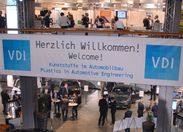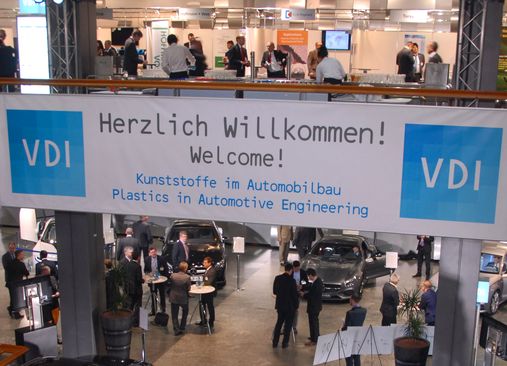Asia
EMEA

LANXESS Canada Contacts
Contact our Sites in Canada
Media Inquiries
General Inquiries
Please click here to e-mail LANXESS Canada with product inquiries and general requests.
Global Press Releases
2018-03-05
LANXESS at the VDI Congress “Plastics in Automotive Engineering”, March 14 and 15, 2018, Mannheim, Rosengarten Congress Center
High-tech thermoplastics for future mobility
- New variation of plastic metal hybrid technology
- New thermostabilization system for polyamide 66
- Continuous fiber reinforced Tepex composites on the rise
Specialty chemicals company LANXESS will be present in Mannheim at the VDI Congress “Plastics in Automotive Engineering” with a special focus on “High-tech thermoplastics for future mobility”. “New forms of mobility such as autonomous driving, the electrification of vehicle power trains, and new logistics concepts are important growth drivers for our polyamides, polyesters and thermoplastic composites,” explains Dr. Martin Wanders, head of global applications development in the High Performance Materials business unit. “Our current development activities focus on materials and technologies for lightweight structures as well as on heat-dissipating, flame-retardant polyamides and polyesters for thermally stressed electrical and electronic components. Another focus is set on polyamides with high thermal stability,” explains Wanders.
Hollow profiles instead of sheet metal
One highlight at the LANXESS booth is the new “Hollow Profile Hybrid Technology”. This new process- and lightweight design technology is a further development of the classic plastic metal hybrid technology for automotive mass production. Instead of sheet metal, hollow metal profiles with round or square cross-sections are used in combination with polyamide 6 injection molding. “Due to their dimensional stability, hollow profiles enable hybrid parts with significantly higher torsional stiffness and strength. There is an enormous potential for structural components such as cross car beams, which were not resilient enough using conventional hybrid technology,” says Wanders. Like the classical plastic metal hybrid technology, the new process was developed by LANXESS and is simple to realize by injection molding manufacturers. The investment for machinery and tool is low and cycle times are as short as for standard injection molding. A demonstrator part will be shown at the VDI Congress in Mannheim to illustrate the advantages of the new lightweight design technology.
Polyamide 66 consistently stable at temperatures up to 230 °C
Another hot topic at LANXESS is XTS2 thermostabilization (Extreme Temperature Stabilization). It increases the thermal stability of polyamide 66 to up to 230 °C. Wanders: “Important mechanical properties – such as tensile modulus, breaking stress or IZOD impact strength – are maintained at a high level even at constant temperatures of up to 230 °C.” Unlike many other thermostabilization options, the new system shows no stabilization gap between 160 °C and 230 °C. Target applications for XTS2 materials are in vehicles with high efficient combustion engines. The first product from the XTS2 product portfolio is a polyamide 66 reinforced with a 35 percent glass fiber reinforcement. The material will be marketed as Durethan AKV35XTS2. It is ideal for the production of components such as air intake manifolds with an integrated intercooler. Another polyamide 66 with a 30 percent glass fiber reinforcement is under development as well as reinforced polyamide 66 for blow molded hollow components such as air ducts in the engine compartment.
Composites with electromagnetic shielding properties
Another focal topic of the LANXESS presence at the congress lies on the continuous-fiber-reinforced thermoplastic composites of the Tepex brand family. They are becoming increasingly important for lightweight vehicle design and can be found today in more and more series production applications – for example, front end mountings and bumper beams, brake pedals, through-loading systems, and fuel tank reinforcements. “We also see significant potentials for use in vehicle underbodies for the protection of batteries and in new concepts for highly-integrated, multi-position seats for self-driving cars,” explains Henrik Plaggenborg, head of Technical Marketing and Business Development Tepex Automotive. LANXESS is currently developing composite variants with electromagnetic shielding properties especially for components of electrified vehicle drivetrains.
Focus on electromobility
New forms of mobility open up a wide range of potential applications for thermoplastics. LANXESS sees significant potential for the use of its high-tech plastics in charging systems and cell holders for battery systems, in sensors and housings of electric motors, and in the infrastructures of e-mobility, for instance, in public charging stations. “Polyesters and polyamides offer best properties for the production of connectors and components for displays and control units in self-driving vehicles,” says Dr. Anika van Aaken, Project Manager New Mobility in the High Performance Materials business unit.
As an example illustrating the topic of electromobility LANXESS will be showing in Mannheim a bracket for a middle-class electric car made of flame-retardant polyamide 6. Another exhibit at the congress will be a connector housing made from a halogen-free, easy-flowing polyamide 6 reinforced by 45 percent glass fibers.
Forward-Looking Statements
This company release contains certain forward-looking statements, including assumptions, opinions, expectations and views of the company or cited from third party sources. Various known and unknown risks, uncertainties and other factors could cause the actual results, financial position, development or performance of LANXESS AG to differ materially from the estimations expressed or implied herein. LANXESS AG does not guarantee that the assumptions underlying such forward-looking statements are free from errors nor does it accept any responsibility for the future accuracy of the opinions expressed in this presentation or the actual occurrence of the forecast developments. No representation or warranty (expressed or implied) is made as to, and no reliance should be placed on, any information, estimates, targets and opinions, contained herein, and no liability whatsoever is accepted as to any errors, omissions or misstatements contained herein, and accordingly, no representative of LANXESS AG or any of its affiliated companies or any of such person's officers, directors or employees accept any liability whatsoever arising directly or indirectly from the use of this document.
LANXESS is a leading specialty chemicals company with sales of EUR 7.7 billion in 2016 and about 19,200 employees in 25 countries. The company is currently represented at 74 production sites worldwide. The core business of LANXESS is the development, manufacturing and marketing of chemical intermediates, additives, specialty chemicals and plastics. Through ARLANXEO, the joint venture with Saudi Aramco, LANXESS is also a leading supplier of synthetic rubber. LANXESS is listed in the leading sustainability indices Dow Jones Sustainability Index (DJSI World and Europe) and FTSE4Good.
- Gallery




